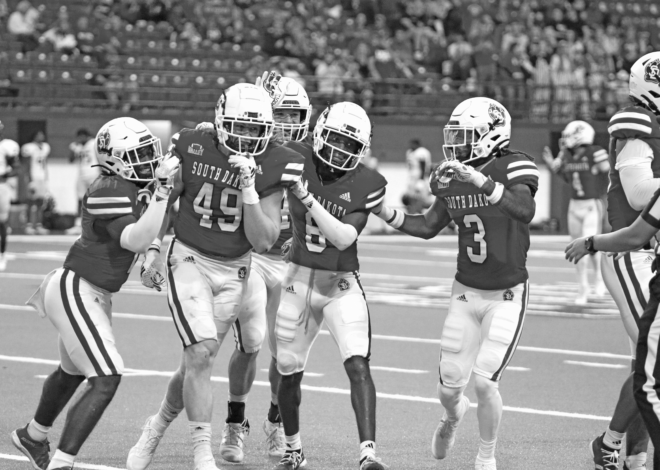USD athletic department breaks even for 2012-13
Between the expenses and revenues for the University of South Dakota Coyotes, the athletic department broke even for the 2012-13 year, with both expenses and revenues coming in at $10,291,561.
The athletic department is comprised of 13 men’s and women’s teams, which are funded through a variety of avenues, including corporate sponsors, endowment funds, student fees, institutional support and ticket sales.
Corporate sponsors
Corporate sponsors are one of the main areas where funding for the department comes from, USD Athletic Director David Herbster said. USD’s corporate sponsorships are managed by Coyote Sports Properties, which is owned by Learfield Sports.
“Learfield gives us a guarantee and then they go out and sell sponsorships,” Herbster said.
Travis Lee, general manager of Coyote Sports Properties, said his company’s goal is to connect businesses and their brands to Coyote Nation.
“We have many opportunities, including through the radio broadcast of games, signage and digital media, for our sponsors to associate their business with our fan base,” Lee said.
Currently, Coyote Sports Properties manages approximately 100 sponsors, though their levels of sponsorships vary, Lee said.
“One sponsor might only pay for a quarter-page ad, while another sponsor may be paying for more,” he said.
Some of the options for sponsors include digital signage in the DakotaDome, sponsoring a tailgate event or halftime game or advertising on GoYotes.com, during radio game broadcasts on USD’s statewide network and in game programs.
“We truly believe we are a difference-maker in driving traffic and building brands,” Lee said.
USD brought in Learfield Sports Jan. 1, 2011. Lee previously managed corporate sponsorships internally, while also overseeing several different aspects of the athletic department.
Jeanette Hubert, USD assistant athletic director for administration said the switch took about $100,000 off the department’s expenses.
By the Numbers
Expenses
$1,863,753 is the reported amount of expenses for the men’s and women’s basketball teams.
$2,687,268 is the reported amount of expenses for the football team.
$3,626,649 is the reported amount of expenses for all other sports.
$10,291,561 is the reported total amount of expenses for the athletic department.
Revenues
$1,863,753 is the reported amount of revenues for the men’s and women’s basketball teams.
$2,687,268 is the reported amount of revenues for the football team.
$3,626,649 is the reported amount of revenues for all other sports.
$10,291,561 is the reported total amount of revenues for the athletic department.
Other major funding
Other major funding for Coyote athletics comes from ticket sales, guarantees from major games, rental income on the DakotaDome, NCAA revenue, student fees and institutional support.
Hubert said now that the university is officially part of a Division I conference, the department will start seeing more conference and NCAA money.
The department also receives a percentage of the revenue from vending and concessions. Scholarships are funded purely by endowments from donors.
The athletic department also hosts sports camps throughout the summer, which ends up being more of a recruiting tool, rather than a source of funding, Hubert said.
“We bring in more than 2,000 kids each summer, which helps us see kids for the first time, but it also gives kids the first taste of campus,” Herbster said.
Budget planning
Herbster and Hubert said careful budget planning helps keep the department on track.
“We’ve already started planning for next year,” Herbster said. “Our fixed costs are scholarships and salaries. We try to estimate what the increase from the state will be so we always start there.”
The next step is to do a budget breakdown for each sport, Herbster said.
“The two biggest line items are travel and equipment, so we try to forecast what each team’s schedule will be,” he said. “Usually we give them a budget and tell them to make it work.”
While the department may manage to break even, Herbster said his department’s budget still isn’t enough.
“We need to get better,” he said. “Tickets, donations, corporate sponsors all need to increase. We have increased every year, but not as fast as we would like. If someone wants to give us a $50 million endowment for scholarships, that’d be nice.”
Herbster said every day is a fundraising day.
“You have to be ready and willing to draw them in, because going D-I was really the only move for us, so now we have to keep working,” he said.
Herbster and Hubert continue to look toward the future for the department.
“The building project will help too, but it’ll be a long road to get there,” Hubert said.
Herbster said the football team has the lowest budget in the Missouri Valley Conference and in the bottom half of the Summit League.
“However, look at the scholarship side,” Hubert said. “Our scholarships are very well funded (for the conference).”
Since making the transition to Division I athletics, scholarship money has increased from $1.4 million to $3 million, Herbster said. Salaries haven’t gone up dramatically, Herbster said, but the department has added more assistant coaches since the transition.
The main change the department has seen is an increase in travel expenses, Hubert said.
“We can’t just go up and down I-29 to play our schedule,” Herbster said. “Our rule is: If the game is within eight hours, you’re getting on a bus.”
Follow reporter Kayla Prasek on Twitter @kprasek

